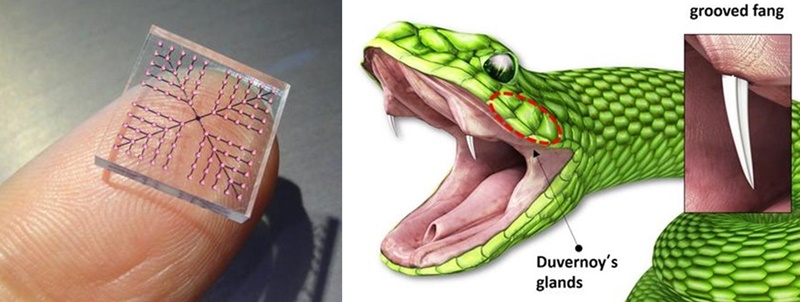
A newly released stamping patch (left) is inspired by the fangs of a rear-fanged snake (right), which has Duvernoy's gland but requires no muscle to push the poison. Such grooved fangs facilitate the easy flow of venom through capillary action, or the ability of water molecules to flow through narrow spaces with no assistance from external forces. (Soongsil University)
By Kang Gahui and Kim Hwaya
A research team has invented a medical stamping patch inspired by rear-fanged snakes that delivers liquid drugs within 15 seconds into the skin.
The National Research Foundation of Korea on Aug. 1 said a research team led by professors Bae Won-gyu from Soongsil University and Jeong Hoon-eui from Ulsan National Institute of Science and Technology created a flexible microneedle patch that injects macromolecular drugs into the skin fast and effectively.
The modern-day syringe invented 167 years ago was inspired by the pressure organs inside a front-fanged snake's head that inject venom by using pressure.
The researchers, however, focused on rear-fanged snakes, which lack pressure organs but can deliver poison within a second. They used the principle of the snakes' grooved teeth that make tiny grooves on the skin and allow the easy flow of venom with capillary action, or the movement of water molecules through narrow spaces.
The skin patch was made with 100 tiny needles modeled after snake fangs through semiconductor processing. Each needle is twice or three times thicker than a human hair and functions as a syringe.
This new stamping patch can also be used in cosmetics. Hyaluronic acid, Vitamin A and other natural plant extracts can be injected into the skin without using hypodermic needle injections.
The research team plans to hold further studies on its invention with pharmaceutical companies.
"By avoiding the pain associated with hypodermic needle injections, we can further strengthen the benefits of a syringe," Bae said, adding, "This result is the innovation to another level of a technique handed down over 167 years."
As part of a project for supporting basic science research by the Ministry of Education, this study was published on the cover of the journal Science Translational Medicine on Aug. 1.
kgh89@korea.kr
Most popular
- Military discharge sets stage for reunion of all 7 BTS members
- BTS to mark 12th anniversary of debut with 2-week festival
- Lee Jae-myung officially sworn in as nation's 21st president
- Presidents Lee, Trump discuss tariff deal in first phone talks
- President's 1st executive order is launch of economic task force
